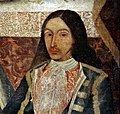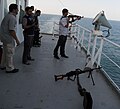Portal:Piracy
Introduction
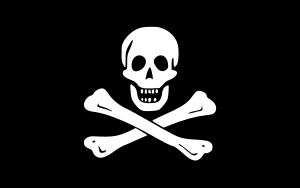
Piracy is an act of robbery or criminal violence by ship or boat-borne attackers upon another ship or a coastal area, typically with the goal of stealing cargo and other valuable goods. Those who conduct acts of piracy are called pirates, and vessels used for piracy are called pirate ships. The earliest documented instances of piracy were in the 14th century BC, when the Sea Peoples, a group of ocean raiders, attacked the ships of the Aegean and Mediterranean civilisations. Narrow channels which funnel shipping into predictable routes have long created opportunities for piracy, as well as for privateering and commerce raiding.
Historic examples of such areas include the waters of Gibraltar, the Strait of Malacca, Madagascar, the Gulf of Aden, and the English Channel, whose geographic structures facilitated pirate attacks. The term piracy generally refers to maritime piracy, although the term has been generalized to refer to acts committed on land, in the air, on computer networks, and (in science fiction) outer space. Piracy usually excludes crimes committed by the perpetrator on their own vessel (e.g. theft), as well as privateering, which implies authorization by a state government.
Piracy or pirating is the name of a specific crime under customary international law and also the name of a number of crimes under the municipal law of a number of states. In the 21st century, seaborne piracy against transport vessels remains a significant issue, with estimated worldwide losses of US$25 billion in 2023, increased from US$16 billion in 2004. (Full article...)
Selected biography -

Charles Gibbs (November 5, 1798 – April 25, 1831) was the pseudonym of an American pirate, born James D. Jeffers. Jeffers was one of the last active pirates in the Caribbean during the early 19th century, and was among the last persons to be executed for piracy by the United States.
His career, like many others during this time, was marked by violence and brutality. Shortly before his execution, Jeffers admitted to have been involved in the killing of as many as 400 victims. His confessions during his imprisonment and trial, detailing his career, were recorded and published following his death and remained popular reading throughout the mid-19th century. However, given the sensationalistic nature of these accounts, historians have questioned the veracity of Jeffers's confessions. (Full article...)Selected article -

Regarded as the last successful pirate of the Caribbean during the 19th century's suppression era, the life of Roberto Cofresí has been romanticized in his native Puerto Rico and neighboring nations. Already possessing a reputation as hard to capture in life, the freebooter became a symbol for an archipelago immersed in the political unrest caused by its status as a colony within the struggling Spanish Empire. Under these circumstances, Cofresí was soon characterized as a benign and generous thief. In a similar trend, he was also associated with the Puerto Rican independence movement of the era. During the late 19th and early 20th century, the abundant oral tradition led to a subgenre of folk hero literature which depicted Cofresí as a benevolent force and contradicted the other pirate-related works of the time, including the well known Treasure Island and Peter Pan. A century later, this contrast became the subject of sociological study. Research to uncover the historical figure behind these myths has also been published by authors linked to the Puerto Rican Genealogical Society, which creates a parallel to this narrative.
While in prison, Cofresí claimed to possess at least 4,000 pieces of eight still accessible after the authorities confiscated his ship, mentioning them in an unsuccessful attempt to bribe an officer in exchange for his freedom. This made him one of the few pirates that are implied to have kept a hidden cache, a rare occurrence despite its prominence in popular culture due to their tendency to divide and misspend the earnings, and fueled legends of buried treasures waiting to be found. All sort of objects serve as the subjects of these tales, from magic guitars made of solid gold to chests that are bound to chains that emerge from the sea. This tendency had extended to Hispaniola by the end of the 19th century, with a novel claiming that the island served as the locale of such treasures. During the 20th century, the destination marketing organizations in the region took notice of them and began exploiting the association of certain places and the pirate to attract tourism. Raising his profile during this time period also led to several non-profit homages. Cofresí has since served as the namesake of several sport teams and events, vehicles, companies, alcoholic brands and hotels. Figures such as Alejandro Tapia y Rivera, Luis Lloréns Torres, Rafael Hernández Marín and Juan Emilio Viguié worked to adapt the legends to other mediums, including plays, popular music and films. Cofresí is also the only pirate of the pre-flight era to have a copycat crime in his stead recorded during the 20th century. This happened when his name was employed as an alias during the first act of sky piracy involving an American airline. (Full article...)Did you know?
- ... that indigenous Australian artist Daniel Boyd has depicted colonial figures including Captain James Cook and Governor Arthur Phillip as pirates?
- ... that the developers of Hotline Miami 2: Wrong Number suggested that Australian customers pirate their game?
- ... that Saudi Arabian broadcaster beoutQ pirated and resold beIN Sports programmes during the Qatar diplomatic crisis?
- ... that since 1904 the Gasparilla Pirate Festival in Tampa, Florida, has featured a pirate-themed parade?
- ... that HMS Redpole, one of the aptly-named coffin brigs, sank in an action with a pirate vessel in August 1828?
- ... that, while it is unknown if pirates actually kept parrots as pets, it is thought that at least some captains kept cats aboard to keep populations of rats and other vermin down?
- ... that in the Golden Age of Piracy, the word "pirate" was often spelled "pyrate" or "pyrat"?
- ... that, unlike traditional Western societies of the time, many pirate clans operated as limited democracies, demanding the right to elect and replace their leaders?
Selected quotations
| “ | I am sorry to see you here Jack, but if you had fought like a man, you need not be hanged like a dog. | ” |
| — Anne Bonny | ||
General images
Selected Jolly Roger
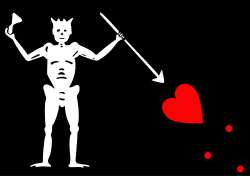
Subcategories
Topics
WikiProjects
Related portals
Things you can do
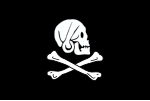
Contribute
- Work on piracy and pirate articles and help improve them to featured articles.
Expand
Join
WikiProject Piracy Requests
- eliminate red links from List of pirates
- expand Timeline of piracy, specifically to fill in vast gap between the 1890s to 2000s
- revise Bartholomew Roberts
- help with Requested articles and Expand articles
- help with Portal:Piracy
- Create Modern Piracy
Associated Wikimedia
The following Wikimedia Foundation sister projects provide more on this subject:
-
Commons
Free media repository -
Wikibooks
Free textbooks and manuals -
Wikidata
Free knowledge base -
Wikinews
Free-content news -
Wikiquote
Collection of quotations -
Wikisource
Free-content library -
Wikiversity
Free learning tools -
Wiktionary
Dictionary and thesaurus



























